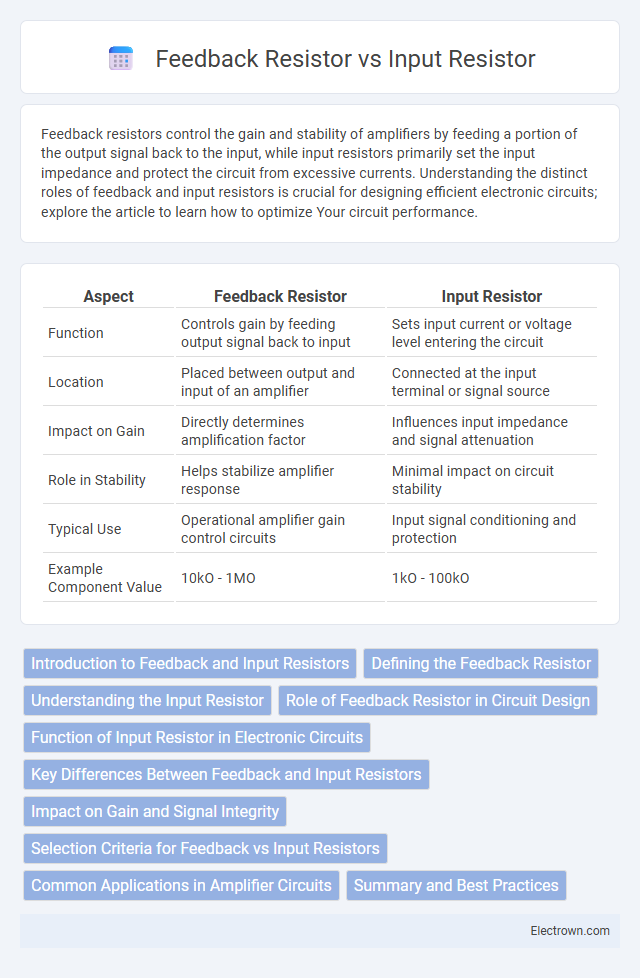Feedback resistors control the gain and stability of amplifiers by feeding a portion of the output signal back to the input, while input resistors primarily set the input impedance and protect the circuit from excessive currents. Understanding the distinct roles of feedback and input resistors is crucial for designing efficient electronic circuits; explore the article to learn how to optimize Your circuit performance.
Table of Comparison
| Aspect | Feedback Resistor | Input Resistor |
|---|---|---|
| Function | Controls gain by feeding output signal back to input | Sets input current or voltage level entering the circuit |
| Location | Placed between output and input of an amplifier | Connected at the input terminal or signal source |
| Impact on Gain | Directly determines amplification factor | Influences input impedance and signal attenuation |
| Role in Stability | Helps stabilize amplifier response | Minimal impact on circuit stability |
| Typical Use | Operational amplifier gain control circuits | Input signal conditioning and protection |
| Example Component Value | 10kO - 1MO | 1kO - 100kO |
Introduction to Feedback and Input Resistors
Feedback resistors control the gain and stability of an operational amplifier by routing a portion of the output signal back to the input. Input resistors set the input impedance and influence the signal biasing and noise characteristics. Both resistors work together to define the overall performance and response of electronic amplifier circuits.
Defining the Feedback Resistor
The feedback resistor is a crucial component in operational amplifier circuits, connecting the output to the inverting input to control gain and stability. Unlike the input resistor, which defines the input signal path and sets the initial current, the feedback resistor determines the amount of output signal fed back to the input, directly influencing the amplifier's closed-loop gain. Precise selection of the feedback resistor value is essential for achieving desired amplification performance and ensuring signal linearity.
Understanding the Input Resistor
The input resistor primarily controls the amount of input current flowing into an amplifier, setting the input impedance and influencing noise levels and signal integrity. In contrast, the feedback resistor determines the overall gain of the circuit by feeding a portion of the output signal back to the input, stabilizing and shaping the amplifier's response. Understanding the input resistor's value and placement is crucial for optimizing signal conditioning and ensuring accurate amplification without distortion or unwanted loading effects.
Role of Feedback Resistor in Circuit Design
The feedback resistor in circuit design controls the gain by regulating the amount of output signal fed back to the input, stabilizing the overall performance and reducing distortion. It directly influences the frequency response and bandwidth, ensuring the amplifier operates within desired parameters. Your choice of feedback resistor value critically impacts precision and linearity in operational amplifier configurations.
Function of Input Resistor in Electronic Circuits
The input resistor primarily controls the input current and sets the input impedance in electronic circuits, protecting sensitive components from excessive current and ensuring signal integrity. It also works to minimize noise and stabilize the voltage levels received by the amplifier or processing stage. Understanding the function of your input resistor is crucial for optimizing circuit performance and maintaining accurate signal processing.
Key Differences Between Feedback and Input Resistors
Feedback resistors and input resistors serve distinct roles in amplifier circuits, with feedback resistors determining the gain by controlling the feedback loop, while input resistors primarily set the input impedance and limit input current. Feedback resistors connect output to input to stabilize and control the amplification, whereas input resistors are placed at the input terminal to protect the circuit and influence signal attenuation. Understanding these differences helps you design precise and stable amplifier configurations tailored to specific performance requirements.
Impact on Gain and Signal Integrity
The feedback resistor primarily defines the closed-loop gain by controlling the fraction of output voltage fed back to the input, directly influencing the amplifier's gain stability and bandwidth. Input resistors set the input impedance, affecting signal integrity by minimizing noise pickup and impedance mismatch with the source. Proper selection and ratio of feedback and input resistors ensure optimal gain accuracy and maintain signal fidelity in amplifier circuits.
Selection Criteria for Feedback vs Input Resistors
Selection criteria for feedback and input resistors revolve around gain accuracy, noise performance, and bandwidth requirements. Feedback resistors are chosen to set precise gain values while minimizing thermal noise and maintaining stability, whereas input resistors primarily influence input impedance and noise contribution. Your choice must balance resistor tolerance, temperature coefficients, and the desired frequency response to optimize overall circuit performance.
Common Applications in Amplifier Circuits
Feedback resistors and input resistors play crucial roles in amplifier circuits, where feedback resistors set the gain by controlling the portion of output voltage fed back to the input, commonly used in operational amplifier configurations such as inverting and non-inverting amplifiers. Input resistors primarily limit the input current and define input impedance, critical for tuning signal levels and protecting the amplifier input stage in sensor interfaces and audio preamplifiers. Together, these resistors optimize performance in signal conditioning, filtering, and gain stabilization across instrumentation amplifiers and audio amplifiers.
Summary and Best Practices
Feedback resistors control gain stability by setting the ratio with input resistors, directly influencing amplifier performance and bandwidth. Input resistors primarily affect input impedance and signal levels, protecting the amplifier input and minimizing noise. For best practices, select feedback and input resistors with low tolerance and temperature coefficients to ensure consistent circuit behavior and optimize your design's reliability.
feedback resistor vs input resistor Infographic

 electrown.com
electrown.com